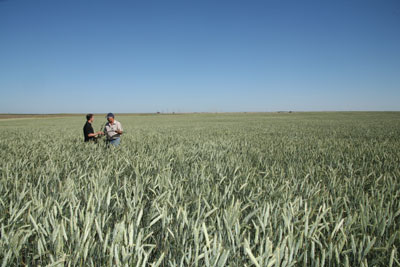
News
New triticale markets in development
Originally, triticale was hybridized from durum wheat and rye, then improved and promoted as a food crop by Manitoba scientists in the 1950s. Yet the only significant food or feed market for it is as silage.
February 24, 2010 By Helen McMenamin
Major initiative aims to make triticale a sustainable feedstock for production of bioplastics, biocomposites, biofuels and chemicals.
Originally, triticale was hybridized from durum wheat and rye, then improved and promoted as a food crop by Manitoba scientists in the 1950s. Yet the only significant food or feed market for it is as silage. That lack of significant food uses is an advantage for an industrial crop, as food is not diverted to industry.

|
| Richard Gibson discusses the potential of triticale with a producer. Photos courtesy of Alberta Research Council. Advertisement
|
Agriculture and Agri-Food Canada researcher Dr. Denis Gaudet at Lethbridge, Alberta, describes triticale as the ultimate Canadian crop. “It grows everywhere from the Maritimes to the west coast, even where nothing but tiny weeds can grow,” he says. “And, it withstands drought, but it’s virtually impossible to over-water it.”
Triticale is easily distinguished from other grains, and if there is inadvertent mixing, its large kernels can be cleaned out. Also, triticale is self-fertilizing and because it doesn’t have close relatives, it does not cross with other plants, so genes are unlikely to spread from triticale to other species, making it an ideal platform for industrial development.
Triticale yields 20 percent more than wheat with moderate inputs, and it produces more starch than CPS wheat, making it competitive with corn for ethanol production. Its high biomass production means that even after silage harvest, considerable biomass remains in the soil to maintain or build soil organic matter.

|
|
| Dr. Denis Gaudet’s group is linking triticale gene sequences to production of particular carbohydrates.
|
Scientists in Gaudet’s group are linking triticale gene sequences to production of particular carbohydrates. With that knowledge, specific metabolic pathways could be enhanced to meet industrial needs, for example, for specific sugars.
The scientists have developed a new method of inserting DNA into the triticale genome. It brings them closer to being able to insert specific gene sequences into precise locations in the plant’s DNA. The technique will allow much more rapid development of designer triticales with more predictable gene expression. By manipulating promoter genes, which turn gene sequences on at a particular time, particular products of metabolism can be produced at specific times or in specific plant tissues. These innovations could find their way into breeding other plant species either for industrial or agronomic advantages.
The scientists also have adapted techniques used in other crop species to culture whole triticale plants from single pollen grains, allowing them to breed plants with new traits from a single parent. These doubled haploid plants have two identical sets of chromosomes so they breed true and the breeding process is shortened by several generations.
To accentuate the unique appearance of the grain, scientists are developing markers to identify industrial triticale and provide traceability from the farm to the biorefinery. They already have a line with distinctive blue kernels, and they are working on other colours.
More breeding for industrial uses
Genetic engineering technology could speed the development of designer triticales with better agronomic qualities, such as crop water use or greater biomass, or for enhanced industrial performance such as lower energy requirements for biomass processing. It could also lead to the development of plants that produce new sugar polymers or have high levels of some of the complex sugars that are in high demand in the chemical industry.
The Canadian Triticale Biorefinery Initiative (CTBI) is a research project that aims to develop sustainable systems to use triticale as a source for materials, chemicals and fuels traditionally sourced from oil. Three years into its 10-year mandate, CTBI’s 130 scientists and technicians in 30 projects have made considerable progress towards its goals.
Biorefining adapts the processes of the refining and petrochemical industries to extract specific materials for specialized uses from recently produced plant tissues. Initially at least, sustainable production is not likely to completely replace petroleum-based chemicals and material processes, but is likely to supplement them, according to Richard Gibson, marketing manager for the CTBI.
Gibson sees “quite staggering potential” for triticale biorefining in the long term, but he believes the program will produce significant rewards within the next few years. “We can produce real products right now by targeting simple applications like using triticale straw in fibre-reinforced plastics,” he says. “Companies are searching for sustainable sources for raw materials.” ARC expects to have a pilot plant operating by 2011 and a commercial scale biorefinery by 2015.
If all goes according to plan, biorefining plants will be located in triticale-growing regions. Some will fractionate the plant material, separating out components, such as fibre, or parts of the grain, and then either ship it elsewhere or process it locally. Remaining material could be used for ethanol production. Others will process grain. Revitalizing the economy of rural centres is a major goal of CTBI. “We’re creating wealth in rural centres,” Gibson says. “Biorefining and related industries will bring opportunities for work and business.”